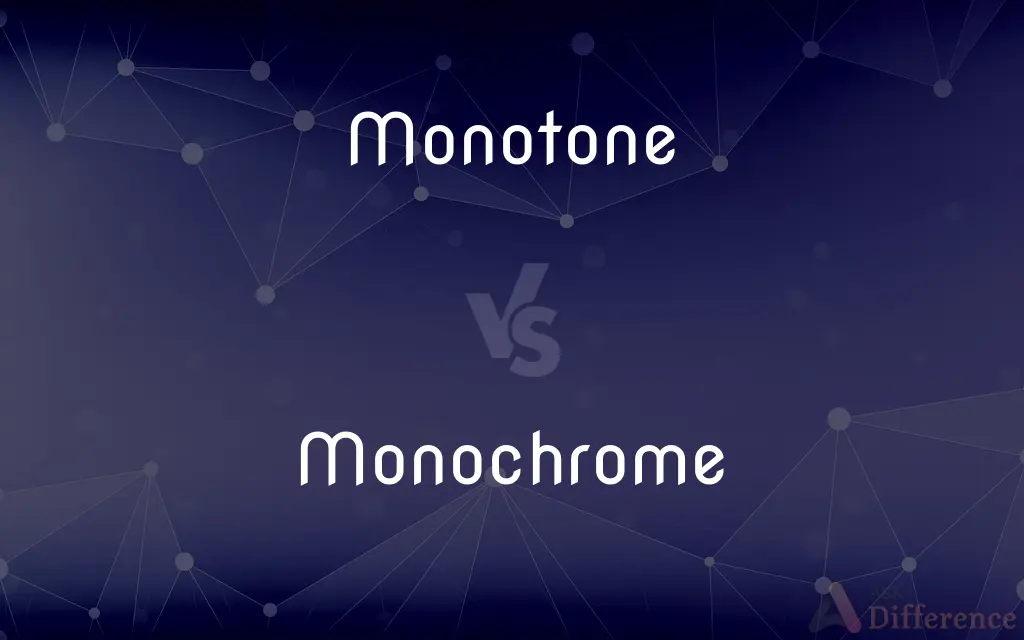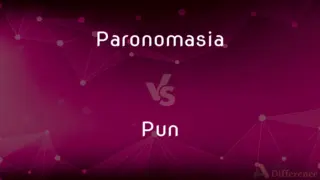Monotone vs. Monochrome — What's the Difference?
By Tayyaba Rehman — Updated on October 17, 2023
"Monotone" refers to a single, unvarying tone of sound, while "monochrome" describes visuals composed of variations of a single color.

Difference Between Monotone and Monochrome
Table of Contents
ADVERTISEMENT
Key Differences
"Monotone" refers to a continuous, unvarying tone, often used in the context of speech or music that lacks inflection or variety. In contrast, "monochrome" pertains to visuals, particularly images that consist of shades of only one color, commonly black and white.
In audio settings, a "monotone" voice could be perceived as boring or lacking in emotion because it doesn't fluctuate in pitch. On the other hand, a "monochrome" design can be stylistically minimalist and impactful, utilizing a single color to create a specific mood or visual effect.
"Monotone" can imply a sameness or lack of variety that's often perceived negatively in sound-related contexts, like music or speech. Conversely, "monochrome" can be a deliberate artistic choice, used in photography or design to focus on composition, light, and form without the distraction of multiple colors.
When someone speaks in "monotone," it's harder to gauge their emotional state because the pitch of their voice doesn't change. "Monochrome" art, however, can evoke strong emotions, as the use of one color or shade can be powerful and evocative.
While "monotone" usually has connotations of dullness and lack of variety in auditory terms, "monochrome" can represent sophistication and focus in visual arts, with many classic films and photographs being admired for their monochromatic composition.
ADVERTISEMENT
Comparison Chart
Definition
Unvarying pitch in sound
Single color in visuals
Context of Usage
Sound, speech, music
Art, photography, design
Connotation
Often negative (dull, boring)
Can be stylistic, sophisticated
Indication of
Lack of emotion/variety
Focus, mood, minimalism
Grammatical Usage
Usually an adjective or noun
Usually an adjective or noun
Compare with Definitions
Monotone
Repetitive and unchanging in sound or style.
The song’s monotone rhythm failed to excite the audience.
Monochrome
A photograph or picture developed or executed in black and white or in varying tones of only one color.
The exhibit featured stunning monochrome photography from the early 20th century.
Monotone
A single musical tone without harmony or variation in pitch.
The exercise required singing a note in monotone for an extended period.
Monochrome
Relating to or denoting a style of art or photography executed in black and white or another single hue.
She loves the simplicity and elegance of monochrome graphic prints.
Monotone
A continuous, unvarying sound or pitch.
He delivered the speech in a dull monotone that put everyone to sleep.
Monochrome
Consisting of or displaying images in a single color or different shades of a single color.
The artist's monochrome painting was a complex mix of black, white, and gray.
Monotone
Lacking in variation, modulation, or inflection in voice.
Her monotone recital of the poem lacked any passion or rhythm.
Monochrome
Lacking in variety and interest due to absence of added colors.
The designer’s monochrome scheme for the room gave it a minimalist feel.
Monotone
Exhibiting a lack of interest or emotion through vocal tone.
His monotone response made it difficult to understand his actual feelings.
Monochrome
A television or computer screen that displays images in shades of a single color.
Before the advent of color displays, monochrome monitors were standard in computing.
Monotone
A succession of sounds or words uttered in a single tone of voice.
Monochrome
A monochromic image is composed of one color (or values of one color). The term monochrome comes from the Ancient Greek: μονόχρωμος, romanized: monochromos, lit. 'having one color'.
Monotone
A single tone repeated with different words or time values, especially in a rendering of a liturgical text.
Monochrome
A photograph or picture developed or executed in black and white or in varying tones of only one colour.
Monotone
A chant in a single tone.
Monochrome
(of a photograph or picture, or a television screen) consisting of or displaying images in black and white or in varying tones of only one colour.
Monotone
Sameness or dull repetition in sound, style, manner, or color.
Monochrome
A picture, especially a painting, done in different shades of a single color.
Monotone
Characterized by or uttered in a monotone
A monotone recitation of names.
Monochrome
The art or technique of executing such a picture.
Monotone
Of or having a single color
A cat with a monotone coat.
Monochrome
The state of being in a single color.
Monotone
Also mon·o·ton·ic (mŏn′ə-tŏnĭk) Mathematics Designating sequences, the successive members of which either consistently increase or decrease but do not oscillate in relative value. Each member of a monotone increasing sequence is greater than or equal to the preceding member; each member of a monotone decreasing sequence is less than or equal to the preceding member.
Monochrome
A black-and-white image, as in photography or on television.
Monotone
(of speech or a sound) Having a single unvaried pitch.
Monochrome
A black and white image, especially such a photograph.
Monotone
(mathematics) Being, or having the salient properties of, a monotone function.
The function is monotone on , while is not.
Monochrome
(dated) A painting executed in shades of a single colour.
Monotone
A single unvaried tone of speech or a sound.
When Tima felt like her parents were treating her like a servant, she would speak in monotone and act as though she were a robot.
Monochrome
A ceramic glaze of a single colour; an object so glazed.
Monotone
A piece of writing in one strain throughout.
Monochrome
Having only one colour.
Monotone
(ambitransitive) To speak in a monotone.
Monochrome
(photography) Representing colours with shades of gray.
Monotone
A single unvaried tone or sound.
Monochrome
A painting or drawing in a single color; a picture made with a single color.
Monotone
The utterance of successive syllables, words, or sentences, on one unvaried key or line of pitch.
Monochrome
Painting done in a range of tones of a single color
Monotone
An unchanging intonation
Monochrome
A black-and-white photograph or slide
Monotone
A single tone repeated with different words or different rhythms (especially in rendering liturgical texts)
Monochrome
Having or appearing to have only one color
Monotone
Of a sequence or function; consistently increasing and never decreasing or consistently decreasing and never increasing in value
Monotone
Sounded or spoken in a tone unvarying in pitch;
The owl's faint monotonous hooting
Common Curiosities
Is "monochrome" only used in art?
No, "monochrome" can refer to any visual element, including photographs, screens, and designs, consisting of one color or shades of it.
Does "monotone" only refer to sound?
Primarily, yes, "monotone" is used in relation to a continuous, unvarying sound or pitch.
What's the effect of "monotone" speech?
Monotone speech can make content seem less engaging and harder to follow due to lack of vocal inflection.
Can "monotone" have a positive connotation?
Generally, it’s seen as negative, suggesting boredom or disinterest, but might be neutral in specific contexts like meditation chants.
Are "monochrome" visuals always in black and white?
No, they can be in any single color, though black and white are common.
Does "monotone" mean the absence of music?
No, it refers to a lack of variation in musical pitch, not the absence of music itself.
Can "monochrome" be a stylistic choice?
Absolutely, it's often used for stylistic, thematic, or emotional impact in various visual arts.
Can music be "monotone"?
If it lacks pitch variation, it might be described as such, though it's rare for actual music.
Are "monochrome" images limited in expression?
No, they can be very expressive, using contrast, shadow, and tone to convey depth and emotion.
Is "monochrome" old-fashioned in photography?
Not necessarily; it remains a popular choice for its artistic and emotive qualities.
Can a personality be "monotone"?
Not literally, but it can describe someone who shows little emotion or variation in affect.
Is "monotone" ever used in visual arts?
Rarely. It's predominantly used in auditory contexts.
Do "monochrome" screens still exist?
They're rare but can be found in specific devices or vintage electronics.
Why choose "monochrome" in design?
Monochrome can bring focus, simplicity, and elegance to a design.
Share Your Discovery

Previous Comparison
Malt vs. Molt
Next Comparison
Paronomasia vs. PunAuthor Spotlight
Written by
Tayyaba RehmanTayyaba Rehman is a distinguished writer, currently serving as a primary contributor to askdifference.com. As a researcher in semantics and etymology, Tayyaba's passion for the complexity of languages and their distinctions has found a perfect home on the platform. Tayyaba delves into the intricacies of language, distinguishing between commonly confused words and phrases, thereby providing clarity for readers worldwide.














































